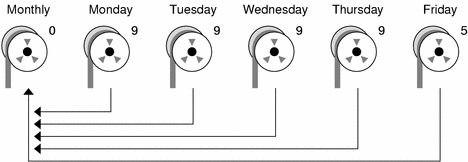Guidelines for Scheduling Backups
A backup schedule is the schedule that you establish to run the ufsdump command. This section discusses guidelines on the factors to weigh when you create a backup schedule. This section also includes sample backup schedules.
The backup schedule that you create depends on the following:
-
Your need to minimize the number of tapes that are used for backups
-
The time available for doing backups
-
The time available for doing a full restore of a damaged file system
-
The time available for retrieving individual files that are accidentally deleted
How Often Should You Do Backups?
If you do not need to minimize time and the number of media that is used for backups, you can do full backups every day. However, this backup method is not realistic for most sites, so incremental backups are used most often. In this case, you should back up your site enough to so that you can restore files from the last four weeks. This schedule requires at least four sets of tapes, one set for each week. You would then reuse the tapes each month. In addition, you should archive the monthly backups for at least a year. Then, keep yearly backups for a number of years.
Backup Terms and Definitions
The following table describes backup terms and definitions.
Suggestions for Scheduling Backups
The following table provides other suggestions for scheduling backups.
Table 46–6 Suggestions for Backup Schedules|
File Restoration Need |
Backup Interval |
Comments |
|---|---|---|
|
To restore different versions of files (for example, file systems that are used for word processing) |
Do daily incremental backups every working day Do not reuse the same tape for daily incremental backups |
This schedule saves all files modified that day, as well as those files still on disk that were modified since the last backup of a lower level. However, with this schedule, you should use a different tape each day because you might otherwise be unable to restore the needed version of the file. For example, a file that changed on Tuesday, and again on Thursday, goes onto Friday's lower-level backup appearing as it did Thursday night, not Tuesday night. If a user needs the Tuesday version, you cannot restore it unless you have a Tuesday backup tape (or a Wednesday backup tape). Similarly, a file that is present on Tuesday and Wednesday, but removed on Thursday, does not appear on the Friday lower-level backup. |
|
To quickly restore a complete file system |
Do lower-level backups more frequently. |
— |
|
To back up a number of file systems on the same server |
Consider staggering the schedule for different file systems. |
This way you're not doing all level 0 backups on the same day. |
|
To minimize tapes |
Increase the level of incremental backups that are done across the week. |
Only changes from day to day are saved on each daily tape. |
|
|
Increase the level of backups that are done at the end of the week. Put each day's and week's incremental backups onto the same tape. |
Only changes from week to week (rather than the entire month) are saved on the weekly tapes. |
|
|
Put each day's and week's incremental backups onto the same tape. |
To do so, use the no rewind option of the ufsdump command, such as specifying /dev/rmt/0n. |
Using Dump Levels to Create Incremental Backups
The dump level you specify in the ufsdump command (0–9) determines which files are backed up. Dump level 0 creates a full backup. Levels 1–9 are used to schedule incremental backups, but have no defined meanings. Levels 1–9 are just a range of numbers that are used to schedule cumulative or discrete backups. The only meaning levels 1–9 have is in relationship to each other, as a higher or lower number. A lower dump number always restarts a full or a cumulative backup. The following examples show the flexibility of the incremental dump procedure using levels 1–9.
Example—Dump Levels for Daily, Cumulative Backups
Doing daily, cumulative incremental backups is the most commonly used backup schedule and is recommended for most situations. The following example shows a schedule that uses a level 9 dump Monday through Thursday, and a level 5 dump on Friday to restart the process.
Figure 46–1 Incremental Backup: Daily Cumulative

In the preceding example, you could have used other numbers in the 1–9 range to produce the same results. The key is using the same number Monday through Thursday, with any lower number on Friday. For example, you could have specified levels 4, 4, 4, 4, 2 or 7, 7, 7, 7, 5.
Example—Dump Levels for Daily, Incremental Backups
The following example shows a schedule where you capture only a day's work on different tapes. This type of backup is referred to as a daily, incremental backup. In this case, sequential dump level numbers are used during the week (3, 4, 5, 6) with a lower number (2) on Friday. The lower number on Friday restarts the processing.
Figure 46–2 Incremental Backup: Daily Incremental

In the preceding example, you could have used the sequence 6, 7, 8, 9 followed by 2, or 5, 6, 7, 8 followed by 3. Remember, the numbers themselves have no defined meaning. You attribute meaning by ordering them in a specified sequence, as described in the examples.
- © 2010, Oracle Corporation and/or its affiliates
